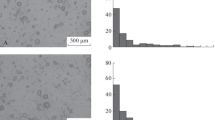Abstract
The practice of using the mixed bed resin (mixture of cation and anion exchange resin) in removing the ionic impurities is widely adopted in various plants including the nuclear reactors. The determination of the mixing ratio by the conventional method exhibits several disadvantages (while the ratio is far from unity, poor color difference between the components and low sample volume etc.). A FTIR based spectroscopic method has been proposed here for the rapid analysis (semi-quantitative) of the mixing ratio and applied on the mixture of nuclear grade cation and anion resin to overcome the difficulties faced by the conventional procedure. The possibility of quantification has also been proposed by extending the present methodology.








Similar content being viewed by others
References
Kunin R (1958) Ion exchange resins. Wiley, London
Helfferich F (1962) Ion exchange. McGraw-Hill, New York
Konrad D (1991) Ion exchangers. Walter de Gruyter. Berlin, New York
Harland CE (1994) Ion exchange: theory and practice, 2nd edn. The Royal Society Chemistry, Cambridge
Zagorodni AA (2007) Ion exchange materials properties and applications. Elsevier, Amsterdam
International Atomic Energy Agency (2002) Application of ion exchange processes for the treatment of radioactive waste and management of spent ion exchangers (technical reports series no. 408), International Atomic Energy Agency, Vienna
Flores-Espinosa RM, Ortíz-Oliveros HB, Olguín MT, Perusquia-Cueto, Gallardo-San-Vicente R (2012) Separation and treatment of ion-exchange resins used in cleaning systems of a research nuclear reactor. Chem Eng J 188:71–76
Lin KH (1973) Use of ion exchange for the treatment of liquids in nuclear power plants, Report ORNL-4792. Oak Ridge, TN
Ion exchange resin for nuclear power industry (1997) Filtr Sep 34(7):640
Bennett A (2007) High purity water: advances in ion exchange technology. Filtr Sep 44(6):20–23
Perie M, Perie J, Chemla M (1991) Nuclear grade resin: kinetics of isotopic and ionic exchanges for borate and chloride anions. J Electroanal Chem 303(1–2):105–124
Singare PU (2014) Radiotracers in performance evaluation of nuclear grade resins Amberlite IRN-78 and Purolite NRW-8000. Kerntechnik 79:51–57
Gregor HP (1951) Gibbs-Donnan equilibria in ion exchange resin systems. J Am Chem Soc 73(2):642–650
Gregor HP, Bregman JI, Gutoff F, Broadley RD, Baldwin DE, Overberger CG (1951) Studies on ion-exchange resins. Capacity of sulfonic acid cation-exchange resins. J Colloid Sci 6(1):20–32
Gregor HP, Bregman JI (1951) Studies on ion-exchange resins. IV. Selectivity coefficients of various cation exchangers towards univalent cations. J Colloid Sci 6(4):323–347
Gregor HP, Sundheim BR, Held KM, Waxman MH (1952) Studies on ion-exchange resins. V. Water vapor sorption. J Colloid Sci 7(5):511–534
Strasheim A, Buijs K (1961) Infra-red spectra of ion-exchangers on polystyrene base. Spectrochim Acta 17(4):388–392
Parrish JR (1975) Quantitative analysis of cation-exchange resins by infrared spectrophotometryand pyrolysis-gas chromatography. Anal Chem 47(12):1999–2003
Bartholin M (1981) Styrene-divinylbenzene copolymers, 3 revisited IR analysis. Makromol Chem 182:2075–2085
van Raij B, Quaggio JA, da Silva NM (1986) Extraction of phosphorus, potassium, calcium, and magnesium from soils by an ion-exchange resin procedure. Commun Soil Sci Plant Anal 17(5):547–566
Rengaraj S, Yeon KH, Moon SH (2001) Removal of chromium from water and wastewater by ion exchange resins. J Hazard Mater 87(1–3):273–287
Yeon KH, Seong JH, Rengaraj S, Moon SH (2003) Electrochemical characterization of ion-exchange resin beds and removal of cobalt by electrodeionization for high purity water production. Sep Sci Technol 38(2):443–462
Liang Z, Chen W, Liu J, Wang S, Zhou Z, Li W, Sun G, Xin Q (2004) FT-IR study of the microstructure of Nafion membrane. J Membr Sci 233(1):39–44
Lokhande RS, Singare PU, Dole MH (2006) Comparative study on bromide and iodide ion-isotopic exchange reactions using strongly basic anion exchange resin Duolite A-113. J Nucl Radiochem Sci 7(2):29–32
Meenakshi S, Viswanathan N (2007) Identification of selective ion-exchange resin For fluoride sorption. J Colloid Interface Sci 308(2):438–450
Alexandratos SD (2009) Ion-exchange resins: a retrospective from industrial and engineering chemistry research. Ind Eng Chem Res 48(1):388–398
Malik MA (2009) Carbonyl groups in sulfonated styrene-divinylbenzene macroporous resins. Ind Eng Chem Res 48(15):6961–6965
Ezzeldin H A, Apblett A, Foutch G L (2010) Synthesis and properties of anion exchangers derived from chloromethyl styrene codivinylbenzene and their use in water treatment. Int J Polym Sci 2010:684051
Siminiceanu I, Marchitan N, Duca G, Mereuta A (2010) Mathematical models based on thermodynamic equilibrium and kinetics of an ion exchange process. Rev Chim 61:623–626
Singare PU, Lokhande RS, Madyal RS (2011) Thermal degradation studies of some stronglyacidic cation exchange resins. Open J Phys Chem 1:45–54
Traboulsi A, Dupuy N, Rebufa C, Sergent M, Labed V (2012) Investigation of gamma radiation effect on the anion exchange resin Amberlite IRA-400 in hydroxide form by Fourier transformed infrared and 13C nuclear magnetic resonance spectroscopies. Anal Chim Acta 717:110–121
Ozer O, Ince A, Karagoz B, Bicak N (2013) Crosslinked PS-DVB microspheres with sulfonated polystyrene brushes as new generation of ion exchange resins. Desalination 309(1):141–147
Acknowledgments
It is a pleasure to thank Dr. P. V. Varde and R. C. Sharma (Reactor Group, BARC, India) for their interest and encouragement in carrying out the present work.
Author information
Authors and Affiliations
Corresponding author
Rights and permissions
About this article
Cite this article
Ghosh, S., Dhole, K., Tripathy, M.K. et al. FTIR spectroscopy in the characterization of the mixture of nuclear grade cation and anion exchange resins. J Radioanal Nucl Chem 304, 917–923 (2015). https://doi.org/10.1007/s10967-014-3906-3
Received:
Published:
Issue Date:
DOI: https://doi.org/10.1007/s10967-014-3906-3




